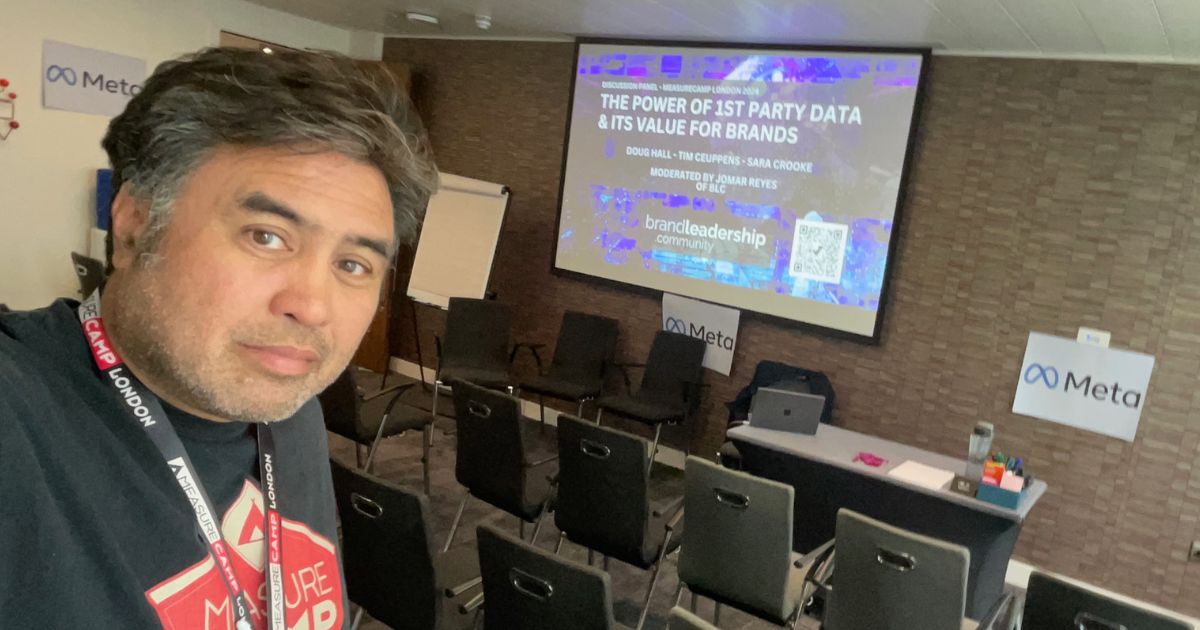The Power of 1st Party Data Fueling Brand Growth
From the Measurecamp London 2024 event, a panel was assembled to discuss the relationship of data and brand value.
The panel of marketing and data experts gathered to tackle one of the most pressing issues in the modern digital landscape: how to leverage 1st party data for long-term brand success.
Jomar Reyes, organizer of Copenhagen MeasureCamp and founder of the Brand Leadership Community, moderated the session, which featured insights from Tim Ceuppens, CMO of a Belgium-based health food brand, Doug Hall, Director of Analytics at Duga Digital, and Sarah Crooke independent data consultant.
Their conversation revealed key insights into how 1st party data not only drives marketing efficiency but also fosters brand equity, strengthens customer loyalty, and aligns entire organizations toward a common goal. Here’s a breakdown of the major takeaways.
1st Party Data: Personalization that Drives Profitability
For Tim Ceuppens, 1st party data is nothing short of essential for his business. “We sell over 2,500 products,” Ceuppens explained, “and some of them are very niche.” Without data-driven personalization, their marketing efforts would waste valuable resources by sending irrelevant offers to the wrong customers. Using 1st party data, his team segments customers based on their preferences, tailoring messaging to match their needs, ultimately improving marketing efficiency.
But personalization isn’t just about relevancy—it’s about profitability. Ceuppens noted that using the right data helps increase the bottom line. Instead of generic email blasts, targeted campaigns reach the customers most likely to engage, buy, and stay loyal. “Having a perfect profile of what everyone wants, needs, and likes makes all the difference for our profitability,” he said.
Beyond the Numbers: Integrating Data Across the Organization
While marketers often focus on personalization, the discussion quickly shifted to the broader potential of 1st party data, especially when integrated across departments. Ceuppens highlighted the importance of using data for operational efficiency. Customer reviews, for example, provide instant feedback on product quality, shipping issues, and customer satisfaction. This data allows his team to respond quickly, improving both product and service.
Interestingly, Ceuppens pointed to an often-overlooked aspect of business: the cost of operations in different regions. Shipping to Sweden, he explained, turned out to be significantly more expensive than expected. “We stopped shipping there because it wasn’t profitable,” Ceuppens said. His competitors, however, continued to ship to the region because their teams weren’t communicating. “The marketing team thought it was great because sales were up, but the finance team didn’t realize the impact on profitability.”
The takeaway? For brands to truly harness the power of 1st party data, they must break down silos between departments, ensuring that marketing, finance, and operations all share a common understanding of what the data is telling them.
The Dangers of Performance Marketing Addiction
Ceuppens’ experience wasn’t just about numbers and operations. He also issued a warning about the overuse of performance marketing—the kind that delivers short-term sales but potentially damages long-term brand equity. He pointed to Nike as an example, claiming the brand had recently sacrificed some of its core values in favor of performance-driven sales metrics.
“If you want to see what focusing solely on performance data does, look at the complete destruction of Nike’s brand in the past year,” Ceuppens said. He explained that the focus on quick wins and immediate sales led to a loss of the brand’s emotional connection with its customers. “This guy [the CEO] came in and just pushed everything for profitability, completely destroying the brand value in the process.”
Performance marketing might look good on paper—especially when it drives revenue—but Ceuppens warned that brands must balance immediate gains with the long-term health of their brand equity. And this is where 1st party data comes back into play.

Doug Hall
Brand Leadership Community
Tim Ceuppens
Brand Leadership Community
Sarah Crooke
Brand Leadership Community1st Party Data and the Omnichannel Experience
The conversation also touched on the growing importance of omnichannel strategies, where brands aim to deliver a seamless experience across all touchpoints—both online and offline. Ceuppens stressed that 1st party data allows companies to provide consistent messaging across different platforms, avoiding fragmented customer experiences.
For Doug Hall, the omnichannel experience isn’t just about smooth customer journeys, but also about making smarter, data-informed decisions. “If you’re using 1st party data effectively, it doesn’t matter whether a customer engages with you online, in-store, or through an app. You’re able to provide them with an experience that feels integrated,” Hall explained.
From Data to Loyalty: The Key to Retention
One of the key takeaways from the session was the link between 1st party data and customer loyalty. Sarah Crooke emphasized that it’s not just about data collection—it’s about using that data to build relationships. Crooke noted that while many companies have moved beyond the basics of tracking data, they often still struggle with turning data into action.
“If your customer base isn’t loyal, 1st party data is useless,” Crooke said. “You need to use that data to create meaningful experiences that bring customers back.” She argued that brands should focus on using data to drive loyalty programs and personalized marketing efforts that turn one-time buyers into repeat customers.
The Future of 1st Party Data: Beyond Reporting
The panel wrapped up with a forward-looking discussion on how brands can maximize the potential of 1st party data. Hall summed it up: “It’s not just about collecting data; it’s about asking the right questions of that data.”
While many brands are now collecting more data than ever before, few are using it to its full potential. The difference, according to Hall, lies in how companies approach the data. Instead of simply using it for reporting, brands need to ask deeper, more specific questions that lead to actionable insights.
The consensus from the panel was clear: as privacy concerns grow and third-party cookies phase out, brands that focus on building robust 1st party data strategies will be the ones that thrive. It’s not enough to collect data—you have to use it to create personalized, relevant experiences that keep customers coming back and build long-term brand loyalty.
Conclusion: The Power of Personalization and Brand Equity
At a time when data privacy is at the forefront of both consumer and regulatory conversations, 1st party data represents a critical opportunity for brands to differentiate themselves. But, as the panelists at MeasureCamp London made clear, it’s not just about having the data—it’s about using it wisely. Whether it’s personalizing marketing, integrating data across departments, or balancing short-term gains with long-term brand health, brands that master 1st party data will be the ones that lead in the years to come.




